Dr Derek Li has over 100 pairs of running shoes and regularly contributes shoe reviews to roadtrailrun.com.
Learn more on how to choose the best pair of running shoes for you, as he explains and breaks down his tips into two parts:
How to Choose a Pair of Running Shoes
To summarise, there are three main things to consider when selecting a running shoe:
-
How much cushioning do you need?
-
How much grip do you need?
-
How much stability do you need?
1. Cushioning
Training shoes tend to have more cushioning than racing shoes and they are used for longer runs, easy runs, and recovery runs.
Racing shoes, which have less cushioning, are lighter and more often used for speed workouts and races.
The first step in choosing a pair of shoes is determining how much cushioning you need.
2. Grip
How much grip you need depends on the surface you’ll be running on.
For example, if you’re running on the track, you’ll need less grip than on the road or on the trail.
More grip, however, isn’t always better.
Rubber outsoles, which provide grip, weigh more than typical foam and gives the shoe a harsher feel under your feet.
That said, having more rubber also means the shoe will be more durable.
The second step in choosing a pair of shoes is determining how much grip you need.
3. Stability
Stability shoes provide runners with support every single step. To determine if you need stability shoes, start off with trying out neutral shoes.
This is because you’ll run the way you’d naturally run in a pair of neutral shoes, and hence a good baseline.
If it doesn’t work for you, e.g. you start developing injuries, try out a pair of stability shoes. Stability shoes help with people who overpronate and it might be your solution.
Determining if you need stability shoe is the last step in choosing a pair of running shoes.
How to Determine Size
Your running shoe should typically be:
-
Half to full size larger than your dress shoe
-
Locking your foot at the ankle and the middle of your foot
-
Not jamming any of your toes
Your foot expands slightly with every step, and this is exaggerated because there’s more impact on each step when you run compared to walking.
Hence, you’ll need more space in your running shoe than in your dress shoe.
Although the larger size might take some getting used to, there’s typically no loss of efficiency when your toes can splay in your running shoe.
Racing shoes are also slightly snugger than training shoes of the same size by the same brand, and it’s meant to be that way to help you run faster in them.
For more content like these, check out ALLSET's YouTube channel. And if you’d like to find out more about ALLSET, they can be found at allset.sg.
Featured Contributor:

ALLSET helps you enjoy a better quality of life through healthy habits because they believe your health matters to not just you, but also those around you. They see meaning in helping you get healthier.
At ALLSET, you can expect passionate professionals in physiotherapy and personal training. They are people who count SEA Games champions, everyday folks, disabled persons, kids, and more as satisfied clients.
Surgeons and doctors trust them to guide you through rehab to top performance, and they’ve learned to treat everyone compassionately. Together with SportSG and dedicated medical partners, their company is also working on an Allwin app, a platform that aims to make professional health and fitness services more accessible for you.
Connect with Allset on their website, Facebook, Instagram and LinkedIn.
.jpg)

